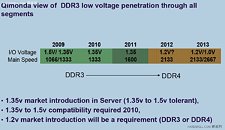Sunday, August 24th 2008
DDR3 to DDR4 Transition Chalked-out, DDR4 in 2012
The transition between PC memory standards has always relied on changes in PC platforms for effectiveness. For example, the LGA 775 saw transition between two standards, the i915 MCH supported DDR and DDR2 memory, i925 onwards it became mandatory for people to use DDR2 memory as the platform required it. In came DDR3 and it became optional for users to choose it over DDR2. Even now, there is only a gradual transit between DDR2 and DDR3. With Nehalem however, it will become mandatory to use DDR3 memory, both with the LGA 1366 and LGA 1160 socket motherboards in either two or three channel configurations.
Qimonda has already chalked out plans for a smooth transition to DDR4 PC memory. According to Qimonda's development plan, DDR4 would be out by 2012. The memory standard will operate at (DDR) frequencies as high as 2,133 MHz at an approximate voltage of 1.2 V and by 2013, we could be seeing 2,667 MHz memory at 1.0 V, a phase during which there's a transition between the current DDR3 and future DDR4 PC memory standards.
Source:
Hardspell
Qimonda has already chalked out plans for a smooth transition to DDR4 PC memory. According to Qimonda's development plan, DDR4 would be out by 2012. The memory standard will operate at (DDR) frequencies as high as 2,133 MHz at an approximate voltage of 1.2 V and by 2013, we could be seeing 2,667 MHz memory at 1.0 V, a phase during which there's a transition between the current DDR3 and future DDR4 PC memory standards.

36 Comments on DDR3 to DDR4 Transition Chalked-out, DDR4 in 2012
Where is ddr4? It is now 2013 and I have seen nothing mention or for sale. Too bad gddr5 isn't being used for pc memory since it is the fastest out there.
Nice thread necro as well.
Haswell-E to use DDR4 memory: www.tomshardware.com/news/Haswell-E-DDR4-Ivy-Bridge,22022.html
It's coming, just not on schedule like most PC tech.
Won't make a difference, because no systems will do any better due to it..
Only people who want Epeen will buy this stuff.
People who know how useless it is, won't..
So DDR4, I'm not holding my breath. XD
But comparing DDR-400 and DDR2-1066, what do you get?
Btw GDDR5 is based on DDR3 but is specially designed for graphics intense tasks.